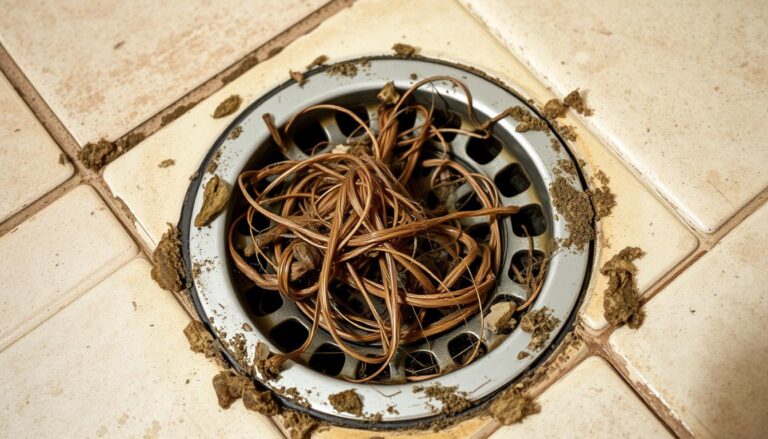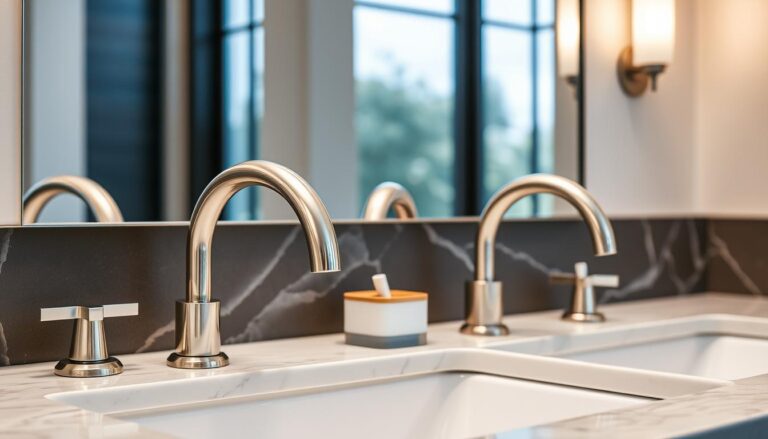How to Unclog a Toilet A Comprehensive Guide
Table of Contents
Dealing with a clogged toilet can be frustrating. But, with the right tools and techniques, you can fix it yourself. This guide will show you how to unclog a toilet, with and without a plunger. You’ll learn about common clog causes, safety tips, and when to call a plumber.
Key Takeaways
- Heavy-duty plungers with ball-shaped heads or rubber flanges are more effective than conventional suction cup-shaped plungers.
- Avoid flushing heavy paper items, such as paper towels, sanitary products, or wipes, as they can lead to clogs.
- Homemade drain cleaners made from baking soda, vinegar, and hot water can help break down obstructions.
- Chemical drain cleaners can be toxic and corrosive, requiring careful use and protective gear.
- Seek professional help for severe plumbing issues that cannot be resolved with DIY methods.
Understanding Toilet Clogs and Their Common Causes
Toilet clogs can be really frustrating. But knowing why they happen can help you avoid and fix them. Things like too much toilet paper or flushing the wrong items can cause clogs.
Types of Clogs and Their Origins
Toilet clogs come from different sources. Here are a few:
- Excessive Toilet Paper – Too much or the wrong kind of toilet paper can block your toilet or septic tank.
- Non-Flushable Items – Flushing things like feminine products, baby wipes, or paper towels can lead to big toilet clog causes.
- Mechanical Issues – Problems with the toilet’s parts, like the flapper or tank water, can also cause clogs.
Signs of a Serious Clog
If your toilet is draining slowly or the water level is rising, it’s a sign of a big problem. You might also smell a bad smell from a septic tank blockage. These are signs you need to act fast.
When to Take Immediate Action
If you think you have a big clog or sewer issue, you need to fix it quickly. Signs like slow draining, rising water, or gas smells mean you should act fast. This helps avoid more damage and keeps your plumbing safe.
Essential Tools and Materials for Unclogging
Dealing with a toilet clog can be frustrating. But, having the right tools makes a big difference. Start with a heavy-duty toilet plunger – it should have a ball-shaped head or rubber flange for strong suction. Also, a toilet auger or “closet snake” is key. It can reach deep into the drain to clear tough clogs.
If you like a natural solution, keep drain cleaner nearby. These products can dissolve clogs. But, make sure they’re safe for your plumbing and follow the instructions carefully.
- Plunger (with ball-shaped head or rubber flange)
- Toilet auger (closet snake)
- Drain cleaner solution
- Rubber gloves
- Towels
- Hot water
It’s also smart to have extra tools ready. A wire coat hanger or a plastic bottle can be used as an unclogger. Always wear rubber gloves and have towels ready to clean up spills.
With this toolkit, you can handle many types of clogs. From small blockages to tough ones, you’ll be ready. With the right tools and effort, you can fix your toilet quickly and avoid the trouble of a clogged drain.
How to Unclog a Toilet
Dealing with a clogged toilet can be frustrating. But, with the right steps, you can fix it quickly. First, check how bad the clog is and then take action.
Assessing the Severity of the Clog
Before you start, see how bad the clog is. If the water is just a bit higher than usual, it’s likely a small clog. But, if the water is rising fast or has spilled over, it’s a bigger problem.
Initial Safety Precautions
First, turn off the water to the toilet. This stops more water from coming in and makes cleanup easier. Also, put towels or a small plastic tarp on the floor to protect it.
Water Level Management
You might need to adjust the water level in the bowl. If it’s too high, use a bucket to lower it. If it’s too low, add water to help with plunging. The right water level is key to unclogging your toilet.
Fixing a clogged toilet might take a few tries and some patience. By following these steps and using the right tools, you can fix your toilet fast. This way, you avoid bigger plumbing issues.

Using a Plunger Effectively
A plunger is often the best tool for unclogging a toilet. To use it well, you need to make a good seal around the toilet’s drain. Start by pushing the plunger’s flange into the bowl until it fits tightly. Then, push down hard and pull up, creating suction to remove the clog.
For tough clogs, warm the plunger with hot water first. The heat makes the rubber more flexible, helping it seal better and pull harder. Use quick up-and-down motions and strong plunges to break the clog.
Using a plunger takes time and patience. It might take a few tries to clear the clog. If it doesn’t work, try other methods like a baking soda and vinegar mix or a toilet snake. Always clean and take care of your plunger to keep it working well.
- Create a tight seal around the toilet’s drain opening with the plunger’s flange.
- Apply firm, steady pressure and pull the plunger up to create suction.
- Run hot water over the plunger to improve its flexibility and effectiveness.
- Use a combination of rapid up-and-down motions and vigorous plunges to break up the clog.
- Be patient and try multiple plunging cycles to clear the blockage completely.
- Clean and maintain your plunger regularly for future use.
Natural Methods: Baking Soda and Vinegar Solution
Unclogging a toilet without a plunger can be easy with baking soda and vinegar. This combo is great for minor clogs and keeps drains flowing well.
Proper Mixture Ratios
The right mix is key for baking soda and vinegar. Use 1 cup of baking soda and 2 cups of white vinegar. This mix fizzles and breaks down clogs.
Application Techniques
First, pour baking soda into the toilet bowl. Then, slowly add vinegar. Let it sit for 5 minutes before flushing with hot water. If it doesn’t work, try again.
Safety Considerations
The baking soda and vinegar mix is safe for most clogs. But, it might not work for tough or non-organic clogs. For those, you might need a plumber’s snake or a pro.
Knowing how to mix and use this method safely helps. It lets you how to unclog a toilet without a plunger and keep your drains working well.

Hot Water and Dish Soap Method
Unclogging a toilet doesn’t need a plunger. The hot water and dish soap method is easy, effective, and safe. It uses common household items to clear out clogs in your toilet.
Dish soap is key in this method. It’s denser than water, so it goes straight to the clog. Pouring about one cup of dish soap into the toilet bowl helps break down the blockage.
Hot tap water, just below boiling, is added next. Wait 30 minutes after adding the hot water. This lets the soap and water work together to dissolve the clog.
Flushing with hot water and dish soap monthly can stop clogs before they start. This method is safer than chemical cleaners and works well in emergencies.
Only use 1/2- to 1-cup of liquid dish soap. Let it settle for about 30 minutes before adding hot water. This simple trick can unclog your toilet without a plunger, saving you money on professional help.
DIY Tools: Wire Hanger and Toilet Snake Alternatives
Dealing with a clogged toilet doesn’t always mean you need a professional plumber’s snake. There are DIY tools you can use to unclog your toilet without needing special equipment.
Makeshift Toilet Snake
One easy fix is to use a straightened wire coat hanger as a toilet snake. Unbend the hanger, leaving a small hook at the end. Then, gently insert it into the toilet’s drain.
Slowly rotate and push the hanger down the pipe to try and dislodge the clog. Be careful not to scratch the porcelain while you’re doing this.
Proper Technique and Safety Measures
- Wear Protective Gloves: Make sure to wear rubber or latex gloves to protect your hands from any contaminants or sharp edges.
- Bend the Wire Carefully: Take your time to slowly and gently bend the wire hanger. Avoid any sharp points that could damage the toilet or your skin.
- Apply Steady, Gentle Pressure: Slowly insert the makeshift snake into the toilet’s drain. Apply steady, gentle pressure to work through the clog. Avoid using too much force, as it could push the clog further down the pipe.
- Consider Other DIY Options: If the wire hanger technique doesn’t work, you can try other household items. For example, a 2-liter plastic bottle filled with water can be used as a makeshift plunger.
While these DIY tools can work for minor clogs, it’s best to call a professional plumber for more severe or persistent blockages. They can ensure the job is done safely and effectively.
Chemical Drain Cleaners: Pros and Cons
Many homeowners use chemical drain cleaners to unclog toilets. They work well for simple clogs from soap or grease. But, they might not solve deeper plumbing problems. Using them too much can harm your pipes.
Chemical drain cleaners are cheap and easy to find. You can buy them for a few dollars at stores. They’re simple to use, just pour the solution down the drain.
But, be careful with these cleaners. They have strong chemicals that can damage pipes if not used right. They might not fix big blockages like broken pipes or tree roots. For these, it’s best to call a professional plumber.
conclusion
To unclog a toilet, you can try using a plunger or alternative methods if one is not available. The plunger is effective for most blocks, but if you lack one, solutions like using hot water, baking soda and vinegar, or a toilet auger can help. It’s important to be patient and avoid using harsh chemicals that could damage pipes.








